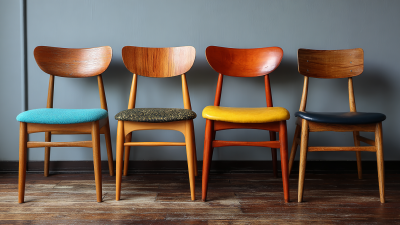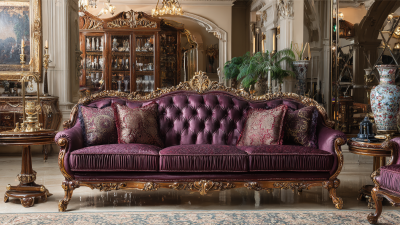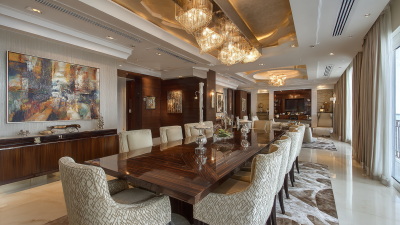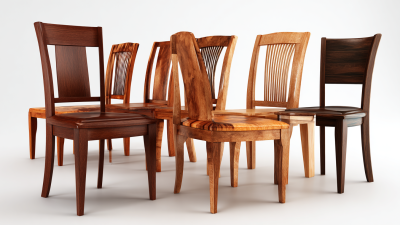
Blog
The Ultimate Checklist for Sourcing the Perfect Solid Wood Dining Room Table
In recent years, the demand for high-quality furniture, particularly Dining Room Table Solid Wood, has surged, driven by a growing appreciation for sustainable, long-lasting products. According to a report by the American Home Furnishings Alliance, over 70% of consumers prioritize durability and craftsmanship when selecting dining furniture, with solid wood tables being favored for their resilience and timeless appeal. This preference not only reflects an increasing investment in home aesthetics but also emphasizes the trend towards eco-friendly materials, as solid wood furniture is often produced from responsibly sourced timber. As families seek to create inviting dining spaces that foster connection and tradition, sourcing the perfect solid wood dining room table has never been more essential. This ultimate checklist will guide you through the critical considerations to ensure that your choice aligns with both your lifestyle needs and design aspirations.

Understanding Different Types of Solid Wood for Dining Tables
When it comes to selecting the perfect solid wood dining room table, understanding the different types of solid wood available is crucial. Each wood type not only brings its unique aesthetic but also varies in durability, grain patterns, and maintenance requirements.
 Hardwoods like oak, maple, and cherry are popular choices for dining tables due to their strength and longevity. Oak offers a robust surface with prominent grain patterns, making it an excellent fit for rustic and traditional decor. Maple, on the other hand, is known for its smooth, fine grain which gives a contemporary look while remaining tough enough to endure daily use. Cherry wood, celebrated for its rich, warm hues, develops a beautiful patina over time, adding character to any dining space.
Hardwoods like oak, maple, and cherry are popular choices for dining tables due to their strength and longevity. Oak offers a robust surface with prominent grain patterns, making it an excellent fit for rustic and traditional decor. Maple, on the other hand, is known for its smooth, fine grain which gives a contemporary look while remaining tough enough to endure daily use. Cherry wood, celebrated for its rich, warm hues, develops a beautiful patina over time, adding character to any dining space.
Softwoods such as pine and cedar are also viable options, especially for those seeking a lighter, more casual atmosphere. Pine is budget-friendly and easy to work with, often showcasing delightful knots and unique patterns. Cedar, while softer, is naturally resistant to decay and insects, making it a great choice for those who may place their table outdoors.
By considering these various wood types, you can ensure that your dining table not only enhances your home’s decor but also stands the test of time.
Essential Features to Consider When Choosing a Dining Room Table
When selecting the perfect solid wood dining room table, there are several essential features to consider that can greatly enhance your dining experience. First, assess the size and shape that will best suit your space. A rectangular table is a classic choice for larger rooms, accommodating more guests, while a round table can foster intimacy in smaller spaces. Additionally, ensure the height of the table complements your dining chairs for optimal comfort during meals.
Another crucial aspect to evaluate is the type of wood used in the table's construction. Different wood species can offer varying levels of durability, aesthetics, and maintenance requirements. For example, oak is known for its strength and timeless appeal, while walnut provides a rich color and unique grain patterns. It's also important to consider the finish of the table. A properly sealed surface will not only enhance the wood's natural beauty but also protect it from spills and scratches, ensuring your investment lasts for years to come. By carefully weighing these features, you can find a dining room table that not only meets your practical needs but also complements your home’s decor.
Design Styles: Matching Your Solid Wood Table to Your Home Decor
When selecting a solid wood dining room table, aligning its design style with your overall home decor is crucial for creating a cohesive aesthetic. A recent report from the American Home Furnishings Alliance found that over 70% of homeowners believe that the dining area is a key space for both functional use and social gatherings. Therefore, integrating a table that reflects your decor style can enhance the warmth and personality of your home.
For those inclined towards modern minimalism, a simple, clean-lined solid wood table in a light finish can serve as a stunning focal point. This design approach not only emphasizes the natural beauty of the wood but also complements the neutral tones typically found in contemporary interiors. Conversely, if your style leans more towards rustic or farmhouse themes, opt for a robust table with rich, dark hues and textured finishes. Research indicates that around 60% of consumers prefer rustic dining setups, favoring pieces that are not only aesthetically pleasing but also exude character and charm, perfect for nurturing a comfortable dining environment.
Sustainability and Sourcing: Finding Eco-Friendly Solid Wood Options
Sustainability has become a pivotal consideration for consumers when sourcing solid wood dining room tables. According to a report by the Forest Stewardship Council, 90% of consumers are inclined to purchase products that are sourced sustainably. This growing awareness has pushed manufacturers to adopt eco-friendly practices, ensuring that wood is harvested responsibly. By opting for tables certified by organizations like the FSC or PEFC, buyers can contribute to forest conservation and biodiversity while also supporting companies that prioritize ethical sourcing.
Moreover, the American Hardwood Export Council (AHEC) reports that sustainable wood products often have a lower carbon footprint compared to their synthetic counterparts. Hardwood trees naturally sequester carbon, making solid wood not only a stunning choice for furniture but also a beneficial one for the environment. As the demand for eco-friendly options rises, manufacturers are increasingly focusing on reclaimed wood and certified timber sources, which significantly reduces the impact on virgin forests. By choosing solid wood tables that emphasize sustainability, consumers not only enhance their home décor but also play a vital role in promoting ecological balance.
Caring for Your Solid Wood Dining Table: Maintenance Tips and Tricks
Caring for your solid wood dining table is essential for maintaining its beauty and durability over time. According to a 2021 report by the American Home Furnishings Alliance, properly maintained wood furniture can last for generations, showcasing not only its craftsmanship but also its sustainability. To keep your solid wood table looking its best, it’s crucial to regularly dust the surface with a soft cloth to prevent scratching and build-up of dirt. Additionally, applying a protective finish, such as wax or oil, every six months can restore its shine and enhance resistance to spills and stains.
Humidity control also plays an important role in the longevity of wooden furniture. The Wood Furniture Restoration Association recommends maintaining indoor humidity levels between 30% and 50%. High humidity can cause wood to swell and lead to warping, while low humidity may result in cracks and splits. Using a humidifier in dry seasons and ensuring proper ventilation during humid months can help preserve the integrity of your table. By implementing these maintenance tips, you can ensure that your solid wood dining table remains a centerpiece of your home for years to come, retaining both its aesthetic appeal and functional value.

Related Posts
-

Round Dining Table and Chairs Comparison Exploring Design Versatility and Space Optimization
-

The Ultimate Guide to Choosing the Perfect Solid Wood Dining Room Table for Your Home
-

Choosing the Right Manufacturer for the Best Modernist Dining Chairs a Comprehensive Guide
-

Solutions for Elevating Your Space with the Best Luxury Furniture
-

Discover Reliable Chinese-Made Dining Room Furniture: Quality You Can Trust for Global Markets
-

How to Choose the Perfect Wood Dining Chairs for Your Home Based on Expert Recommendations
